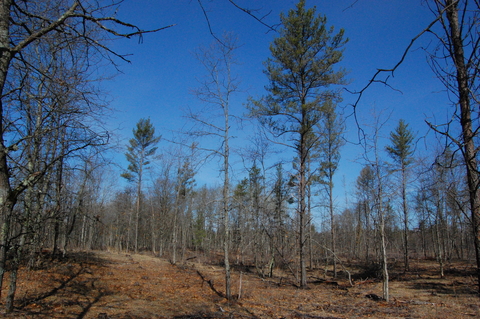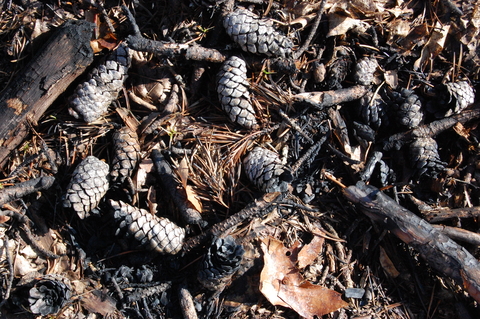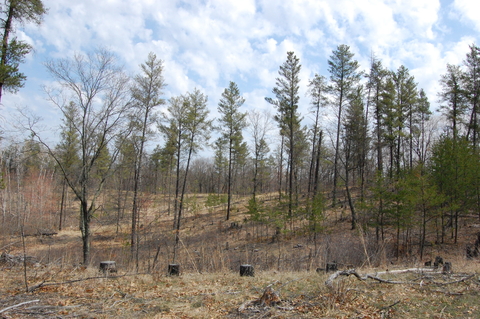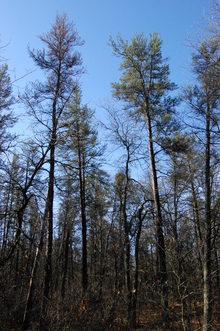Quick facts
- Jack pine grows best on well-drained sandy soils.
- Rotations generally are 40 to 70 years.
- On all soils except dry, sandy soils, species other than jack pine are more productive and valuable for wood product.
- Jack pine seedlings require full sunlight.
- To reduce losses from pests, harvest stands before they reach 50 years.
Jack pine is mainly used for pulpwood, but also for poles and small sawlogs. It is moderately useful for deer food.
Young trees may be heavily browsed where deer populations are high. The deer will eat the trees’ buds and twigs. Dense, young stands provide cover for snowshoe hares. Dense sapling and poletimber stands offer some wildlife shelter, but not as much as most other conifers.
Older jack pine stands are usually less dense than other conifer stands. This allows understory shrubs and herbaceous plants to grow, offering food and cover to wildlife.
Growing conditions
Jack pine grows in extensive pure stands, but is frequently mixed with red and white pine, aspen, paper birch and oak. Less often, it is mixed with black spruce, white spruce and balsam fir.
Jack pine grows best on well-drained sandy soils where the midsummer water table is four to six feet deep. It is more common on dry sandy soils where it grows poorly, but better than most other species. It is also found on glacial eskers, sand dunes and rocky soils.
Jack pine does well on moderately acidic soils, but it will tolerate slightly alkaline conditions. It grows poorly in areas of shallow bedrock and heavy clay soil.
A shade-tolerant species, jack pine is a pioneer species that typically is the first to colonize burned areas and bare mineral soil. Unless the soil is dry and sandy, it is usually succeeded by more shade-tolerant species.
Regenerating jack pine
A rotation is the number of years required to establish and grow trees to a desired size, product or maturity.
Although jack pine is short-lived, stands sometimes survive up to 100 years. Individual trees may live for 200 years on good sites. Commercial rotations generally are 40 to 70 years. Mature trees in these stands range from 8 to 12 inches diameter at breast height (DBH).
Jack pine cones in parts of its range are serotinous; they remain closed at maturity and only open when exposed to intense heat, such as heat from a fire. They persist on trees for years, leading to large seed accumulations.
In the southern part of the range, cones typically open as soon as they mature. Good seed crops occur at three- to four-year intervals starting at about age 20. But the best seed production occurs on trees 40 to 50 years old.
On all soils except dry, sandy soils, species other than jack pine are more productive and valuable for wood products. If your management goal is to produce timber, it is recommended that you convert the stand to another species.
If your mixed stand has enough other, more desirable species, you can make the conversion by harvesting the jack pine in several cuts. If desirable species are not well-stocked, convert the stand by clear-cutting and planting another species.
Direct seeding may be successful where:
- The water table is within a few feet of the surface.
- There is frequent precipitation during germination and early seedling development.
Coat the seed with bird and rodent repellents, and sow it at a rate of 20,000 viable seeds per acre. It is best to seed in early spring to take advantage of snowmelt waters and spring rains.
You may need to plant seedlings where direct seeding failed or on deep, dry sandy soils. While you can only plant bare-root seedlings in the spring, container-grown stock can be planted into early summer. It is usually recommended to space trees six to eight feet apart.
Jack pine seedlings require full sunlight. Clear-cutting creates the best conditions for regeneration, but seed tree or shelterwood systems may be appropriate depending on the stand and site conditions.
Clear-cutting
Clear-cutting is recommended if you will be establishing a new stand by:
- Planting improved seedlings.
- Direct seeding.
- Scattering serotinous cones from high-quality trees.
After clear-cutting, you can scatter branches bearing serotinous cones on bare mineral soil. The sun’s heat near the ground surface will open the cones and release the seed.
If the mature stand is not a suitable seed source, burn the site to destroy slash (woody debris generated during logging). Then, plant or seed the area using a desirable seed source.
Seed-tree method
The seed-tree system is a possible alternative for stands that have 10 seed trees per acre that:
-
Are well-distributed.
-
Are of desirable quality.
-
Have an abundant supply of non-serotinous cones that do not require intense heat to open and release seed.
After the harvest, burn the area to consume slash, kill competition and prepare a favorable seedbed. Burn slash as soon as possible after harvest. This minimizes the risk of seed trees being uprooted by wind before they cast seed.
To slash jack pine, you need a month of warm, dry weather to cure the wood sufficiently to burn. Early spring fires allow you to seed in the early spring. If rodent populations are low, late fall burning and seeding may be almost as effective.
Intermediate treatments
Most natural jack pine stands are understocked. If dense seedling or sapling stands do develop, they will stagnate if they are not thinned.
In very dense seedling stands (i.e., 10,000 trees per acre) it is less expensive to mechanically clear strips than it is to thin to produce 800 to 1,000 uniformly spaced crop trees per acre. Mechanically clear strips about eight feet wide and leave strips about two feet wide.
Thin pole-sized stands if you want poles or sawtimber.
Because pulpwood is the main crop, pruning is not recommended.
Pest management
To reduce losses, harvest stands before they reach 50 years.
To maintain vigorous stands on good sites, thin regularly. By doing so, you:
- Remove suppressed and low-vigor trees.
- Avoid damage to residual trees.
- Reduce flower production.
- Help control both budworms and bark beetles.
To minimize budworm buildup, avoid open-grown trees with large crowns and stands with suppressed trees. If budworms kill the tree tops, harvest the stand within a few years to avoid loss due to heart rot.
To avoid bark beetle damage, follow these guidelines:
- If you thin or cut in the winter or early spring, remove logs and slash before June 1.
- If you thin or cut in the summer, remove logs and slash within three weeks.
- Remove or destroy woody debris greater than three inches in diameter.
- Avoid wounding trees during thinning and harvesting operations.
- Avoid wounding residual trees during thinning.
Heart rot and shoestring root rot are important diseases. Infected trees will show discolored needles and thin canopies. You can sometimes see a thick, black shoestring-like fungus under the bark near the base of the tree.
Reviewed in 2018






